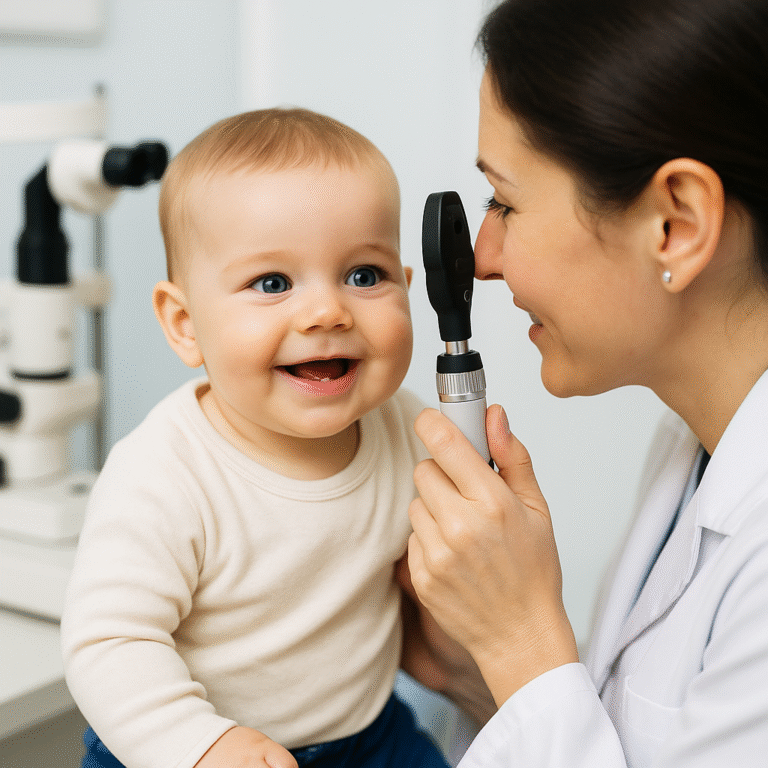Ensuring your baby’s eye health is vital—these tiny explorers rely on their vision to discover the world around them. So, do babies need vision insurance? Understanding vision coverage early offers peace of mind and proactive care.
Why Vision Care Is Essential for Infants 🍼
From birth, a baby’s visual system develops rapidly. Early detection of conditions like amblyopia (lazy eye), strabismus (crossed eyes), or congenital cataracts is crucial for healthy development. These issues can impact learning, coordination, and even social engagement if left unchecked. Expert guidelines stress that early intervention leads to better long‑term outcomes.
What Is Vision Insurance? Parent-Friendly Breakdown
Vision insurance is a supplemental plan separate from general health insurance. It typically covers routine eye exams, glasses, and sometimes contacts. For babies, it also supports early screenings and treatments not always included in basic medical plans.
Common Infant Eye Conditions That Benefit from Coverage
Babies may face several eye issues that warrant attention:
-
Congenital cataracts – clouded lenses present at birth
-
Strabismus – misaligned or wandering eyes
-
Amblyopia – reduced vision in one eye
-
Retinopathy of prematurity – a risk for preemies
Timely detection—often between 6–12 months—is essential for effective treatment.
Does Health Insurance Usually Cover Infant Eye Care?
Under US law (the ACA), all health plans covering individuals under 19 must include pediatric vision as an essential benefit. This typically includes annual eye exams and one pair of glasses. However, the specifics—such as copays, frequency, and frame allowances—depend on your plan and state benchmark.
When Should Babies Have Their First Eye Exam?
-
Newborn (0–1 month): Pediatricians perform red-reflex tests at birth and during early well-baby visits.
-
6–12 months: Optometrist/ophthalmologist conducts comprehensive exam—programs like InfantSEE offer no-cost exams here.
-
By 3 years: Another full exam, especially before school age.
Is Vision Insurance Worth It? Smart Cost-Benefit Analysis
-
Average costs without insurance: Infants and kids may pay $100–$200 per exam.
-
With vision insurance: Copays are often $10–$40 per visit.
-
Break-even point: If your baby needs even one corrective device (glasses) or follow‑up care, the plan usually pays for itself.
-
Peace of mind: Knowing coverage is in place eases stress at every developmental milestone.
Alternatives to Traditional Vision Insurance
-
FSAs and HSAs: Cover exams, glasses, contacts with pre-tax money.
-
Discount vision plans: Provide savings on eyewear without full insurance.
-
Nonprofit/charity programs: Offer free exams and glasses—e.g., InfantSEE, VSP Eyes of Hope.
How to Pick the Right Plan for Your Baby
-
Network strength – Ensure pediatric optometrists/ophthalmologists are covered.
-
Exam frequency – Does the plan allow exams every 6 months?
-
Lens & frame allowances – How much is covered for a quality pair of glasses?
-
Copay/deductible structure – Compare typical out-of-pocket costs.
-
Vision vs medical insurance – Confirm what’s covered as preventive vs medical.
Long-Term Advantages of Early Vision Care
-
Learning readiness: Clear vision supports reading and classroom success.
-
Motor skills development: Clarity of sight aids in walking, coordination, and ball play.
-
Prevents behavioral issues: Vision struggles often cause frustration or misdiagnoses.
-
Supports self-esteem: Proper vision fosters more confident and engaged children.
Debunking Myths About Infant Vision Insurance
-
Myth: “Babies don’t need eye exams.”
Truth: Experts recommend multiple screenings even if no issues appear . -
Myth: “Health insurance covers everything.”
Truth: Routine pediatric vision may be covered, but glasses and specialist fees often require supplemental vision plans. -
Myth: “Vision insurance is too costly.”
Truth: Many insurance premiums are under $15/month—well worth the value if any treatment is needed.
Conclusion
Choosing vision insurance for your baby is not just practical—it’s a powerful step to ensure healthy development and confidence. With expert-backed screening timelines, affordable coverage options, and long-term benefits, this investment brings clarity and calm. When faced with vision-related growth, being prepared makes all the difference.
FAQs About Do Babies Need Vision Insurance
At what age should an infant have their first complete eye exam?
Experts recommend a specialist-led eye exam around 6–12 months, even if all early screenings appear normal .
Does regular health insurance cover baby eye exams and glasses?
ACA-compliant plans cover pediatric vision screenings, exams, and glasses, but details (copays, allowances) differ by state benchmark plans.
How much does a child’s eye exam cost without insurance?
Without vision coverage, a pediatric eye exam typically ranges from $100–$200, depending on tests involved .
Are there free infant eye exam programs available?
Yes! InfantSEE (6–12 months) and VSP Eyes of Hope offer no-cost exams and glasses to eligible babies through select providers.
Should parents compare this topic with is lipedema surgery covered by insurance or how much is bupropion without insurance?
Definitely. Just as it’s smart to ask is lipedema surgery covered by insurance, evaluating whether vision care is covered gives clarity. Also, knowing how much is bupropion without insurance is key to budgeting; same goes for managing vision care costs. These comparisons strengthen internal linking for seamless navigation.
